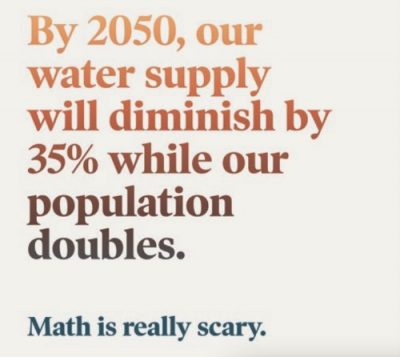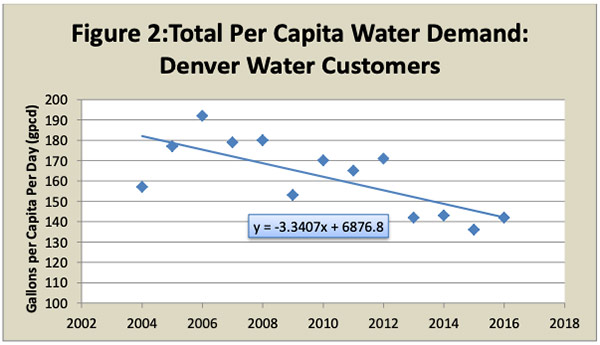The message above was copied from the ‘Funding Colorado’s Water Plan’ document published by the Denver-based Colorado Contractors Association. Some folks might believe that the population of Colorado will double by 2050, and that the amount of water available to Colorado farmers and other residents will diminish drastically… to a mere 65 percent of what we enjoyed in the 1990s. The Denver-based business coalition known as “For the Love of Colorado” would apparently like us to accept those projections as proven facts.
Meanwhile, many Denver leaders want to see the Colorado’s largest city continue growing, along with the surrounding Metro area. So we have a dilemma here. How to grow a city, when the entire American West is headed for a water crisis?
The City of Denver and its water provider, Denver Water, have been leaders in Colorado’s water conservation effort, thanks to a ten-year “Tap Smart” conservation program begun in 2007. According to a 2018 report by Lisa Buchanan of LRB Hydrology & Analytics, Denver Water reduced its total water deliveries over that 10-year period from about 250,000 acre-feet to about 230,000 acre-feet, even though the population of Denver Metro increased during those same 10 years from about 2.7 million to 3.1 million.
Here is a chart from Ms. Buchanan’s report, showing the ‘per capita’ reduction that resulted largely from the “Tap Smart” program, with a ‘trend line’ calculated by Ms. Buchanan:
This type of change — reduced per capita water consumption over the past ten or twenty years in municipal areas — is not unique to Denver Metro. Here in Archuleta County, most of the core urban and suburban areas are served by the Pagosa Area Water and Sanitation District (PAWSD) and we’ve seen a pretty significant reduction in per capital water consumption. In the year 2001, PAWSD sold about 510 million gallons of treated drinking water, to a county-wide population of about 10,500 full-time residents. That’s about 133 gallons per person per day. (This is not an accurate number of actual PAWSD per capita deliveries, but it can serve as a rough guide.)
In 2018, PAWSD sold 402 million gallons to about 10,000 customers. That’s about 110 gallons per person per day.
Not everyone in Archuleta County uses PAWSD water — and in fact, we don’t have an accurate reckoning of the number of full-time residents who use PAWSD water — but based on the above numbers, it would appear that our per capital water use here has declined on a curve similar to what Ms. Buchanan documented for Denver Water.
Nor is this type of water conservation unique to Colorado. One of the most water-challenged cities in America — Los Angeles — began encouraging water conservation efforts in the 1970s, gradually adding penalties, rebates and incentives over the next 40 years. According to a 2015 report, per capita water consumption in LA fell from about 190 gallons per day in the mid-1980s, to around 155 gallons in 2004.
The slow decline continued through 2010, dropping to about 125 gallons per person.
From an article in Wired magazine, written by reporter Matt Simon in 2018:
California is in trouble. Computer models show that with climate change will come harsher droughts and less frequent, yet more powerful storms. The state is not ready for this new reality, but one city south of Porterville could teach California how to survive desiccation: Los Angeles.
That is not a typo.
Agreed, Los Angeles doesn’t exactly have a sterling reputation as a responsible consumer of water. After all, in the early 1900s it drained Owens Lake, 200 miles away, materializing a dust bowl in its place and [giving a shrug to] local residents… These days, it imports the vast majority of its water from Northern California and the Colorado River to the east at a cost of hundreds of millions a year.
But Los Angeles is in the midst of an aqueous awakening, setting an ambitious goal to cut its reliance on imported water in half by 2025 by following an increasingly urgent rule of good water policy: diversification. In a nutshell, that means getting your water from a range of sources — rain capture, aquifers, wells, desalination, even right out of the air. A study from UCLA earlier this year even said the city could feasibly reach 100 percent locally sourced water. To do it, the city is diving into a series of high- and low-tech campaigns that could transform Los Angeles into a model city for water management…
Again, not a typo…
We can note, here, that Los Angeles is drawing water from the Colorado River. Under a series of agreements, Los Angeles and other California communities are entitled to draw 4.4 million acre-feet of water annually from Colorado River — about one-third of the total flow of the Colorado River in an average year.
Yes, cities and towns can put programs in place that help reduce the municipal water consumption. Some reductions also take place due to normal cultural changes; people in the American West are generally aware of current and pending water challenges and have made personal decisions to reduce their water use.
But…
These comments from a 6,000-word article by Susan Green in the Colorado Independent suggest that agriculture — by far the biggest consumer of Colorado water — is not pulling its weight in terms of water conservation. Ms. Green’s article is basically a 27-page critique of the 2015 Colorado Water Plan written during the Hickenlooper administration. Here, we are listening to Denver Water CEO Jim Lochhead:
“We and the other Front Range water utilities are all basically moving as fast as we can through water efficiency. It’s not something we need to be told to do or incentivized to do by the state. It’s something that we’ve been doing and paying for by ourselves for a long time,” Lochhead said…
…Though most of Colorado’s large municipal water districts are willingly embracing further conservation efforts, their managers say the additional water they’ll collectively be able to save won’t be nearly enough to meet Hickenlooper’s 400,000 acre-foot statewide conservation goal.
“The numbers aren’t realistic because the margins don’t make sense. It’s not feasible to expect all the conservation to come from municipalities when they don’t use even close to most of the water in the state,” said Alexandra Davis, Aurora Water’s deputy director and head of its water resources division.
“What the plan doesn’t say – what nobody will say out loud – is that some of the conservation burden is going to have to fall on agriculture, because there’s nowhere else for it to come from. It just is. We need to face that idea rather than pretending that agriculture doesn’t need to be part of this equation.”


